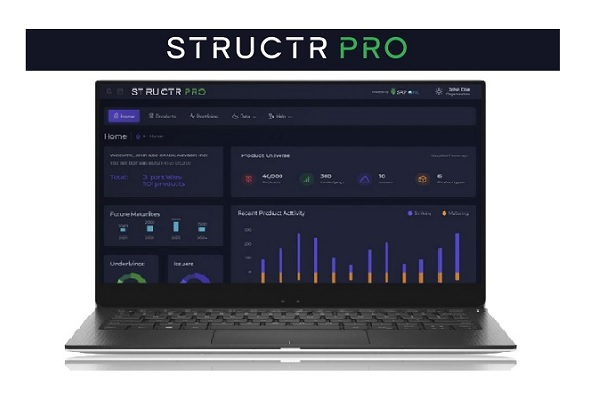Most retail structured products link to equity underlyings and in most cases the natural vehicle is an index. A flagship index covering one or more regions can be the obvious choice, particularly for first time investors in structured products. These include the S&P-500 in the USA, Eurostoxx-50 in Europe, Nikkei 225 in Japan and the MSCI World Index for more global coverage.
Such indices are generally quoted in the press through their price return versions, that is with dividends paid out and not re-invested. In order to calculate the total return that an investor would receive it would be necessary to add back in these dividends. Futures and options are traded on the price return version of indices which gives a significant trading advantage necessary for product construction. Furthermore, using them instead of the total return version gives an optical advantage in structured product terms. Not surprisingly therefore, the overwhelming majority of structured products are issued using price return indices as the underlying. This does however create several problems and issues.
A question of dividends
Firstly it is not really logical to omit dividends because in many markets they are an important part of overall equity return. Secondly, since investment banks will have to buy the index or stocks to delta hedge any long exposure structured product this creates a large one way dividend risk with extremely limited opportunities to hedge away. The issuing bank will keep the dividends received as part of their hedging cashflows and offset them against the future product payout. As a result, the bank is exposed to dividends falling over the life of the product since there would be no reduction in liabilities. This effect was seen in 2020 to drastic effect as companies cut or cancelled intended dividend payments in order to keep cash in hand to deal with the severe economic uncertainty and loss of future income.
Typically therefore banks are reluctant to give the full dividend value when they price the product because of the inherent risk. An index that is expected to pay 3% p.a. dividend yield may see the “implied” level of dividends trade at 2.5% as banks seek a cushion for the risk taken on. It is the investor that loses out over the long run because they are being compensated less than the expected yield on the index. Linking to a total return index would eliminate this problem since dividends would be reinvested and the bank is not exposed to estimating future dividend payments, however as we have observed this approach is unpopular due to the optically less attractive terms that can be achieved (in participation levels or income yields for example) compared to the price return index equivalent.
Concept of decrement indices
Thus the decrement index was created to attempt to solve the issue of dividend risk that the bank does not want and to avoid a situation that is bad for the investor but without making the index less attractive in pricing terms. A decrement index will define a fixed rate (synthetic dividend or fee level) either as a yield or points amount. It is constructed as a total return index (including dividends) and then deducts the defined amount typically on a daily accrual basis.
The yield versions select a decrement rate of usually around 5%, even though this is generally significantly higher than most actual dividend yields. By way of example, consider an index that starts at 100 and pays dividends at 3% (3 units over a one-year period) and shows 10 units of capital growth in one year. The price return index would be at 110 after one year (a 10% return) and the total return version would add back in the dividends to get to around 113, making a 13% return. A 5% fixed yield decrement index would have deducted this yield over the year and be at approximately 108%.
Over the long term real dividend yields tend to stay approximately constant, so that if equity markets grow substantially this is because profits and prospects have improved and therefore firms have more earnings to pay out to their shareholders. This relationship is not entirely straightforward since dividend yields are also affected by interest rates, inflation, taxation and the popularity of the use of other measures such as share buybacks. This logic explains why most decrement indices use fixed yields.
However in the short term the expected dividend amount of mainstream indices stays constant in most circumstances – a 10% change in the index will see an inverse move in the dividend yield if the dividend amount estimates have stayed constant. This phenomenon has been used to justify some fixed amount decrement indices.
These differ from the yield versions in that a fixed dividend amount is deducted per year. For example a decrement index may be created when the parent index is at EUR 1000 and deducts 50 index points per year. This also represents a 5% yield equivalent. However if the index falls to say 800, 50 points per year are still deducted which then represents a running yield of 6.25% p.a.. This would reduce as a yield if the index went up.
Popularity in Europe
The three decrement indices with the highest structured products sales volume in 2019 as reported by www.structuredretailproducts.com are the SBF Top 80 EW Decrement 50 Points (based on the SBF 80 which is an extended version of the popular French CAC40 index), the Euronext France Germany Leaders 50 EW Decrement 5% Index and S&P Euro 50 Equal Weight Synthetic 5% Price Index.
As can be seen from these top three indices, the use of decrement indices is most popular in Europe. Their use is mostly emanating out of some of the more quantitative minded investment banks always looking for the next innovation. The advantage of a decrement index is to eliminate dividend risk but the level of reduction of the index is often not appreciated. This is especially true of longer dated products where this effect is magnified.
Whether this type of index can be properly understood by an investor or adviser is highly questionable, particularly as the naming convention is similar to the parent index they are created from. Of particular concern are the fixed decrement points version, such as the SBF 80 EW decrement 50 point index, the most popular decrement index used in structured products.
This index was at 1065 in February and a month later stood at 650. Bearing in mind that 50 points will be deducted regardless of index level. This means the dividend yield has jumped from 4.7% to 7.7% p.a.. The index has since recovered to 900.
Increased downside risk
Consider a 10 year product that is issued at start level of 800. If we concentrate on the downside risk, which is generally applicable at full maturity, a simple analysis shows that for any scenario where the product has stayed in force for the full ten years, 500 index points has automatically been deducted along the way. Given that the index starts at 800, in simple terms 300 is left for the investor in a sideways market, less if markets are falling. This is quite a sobering thought and highlights the downside risk and why barriers may look attractive optically but are less generous in reality. We can think of the behaviour of this type of index as like a highly leveraged company with huge levels of debt to service every year ahead of rewarding the shareholders.
Finally we can observe that the use of decrement indices is extremely popular in ESG indices. There are some obvious reasons for this, both trends started at similar times a few years ago, and both are popular in Europe. ESG has become a powerful theme for many investors wanting to take an ethical stance whilst also trying to reduce volatility within their porfolios. The creation of these indices by the index companies and investment banks has become the vehicle by which many ESG linked structured products are issued. It remains to be seen how these indices play out for the investor in the next few years in terms of performance and transparency and whether the ESG experience in structured products is tarnished as a result.
Tags: Stress testing Investment Product typesA version of this article has also appeared on www.structuredretailproducts.com













